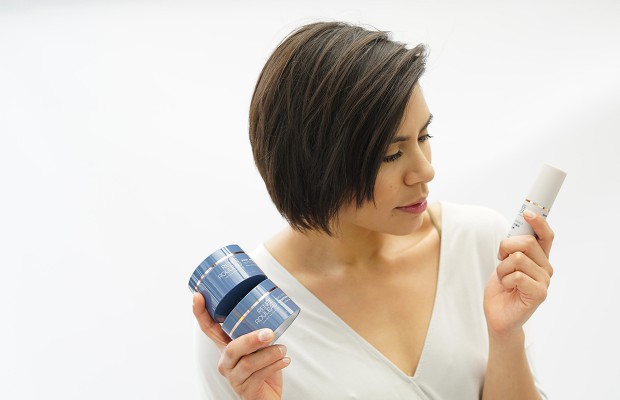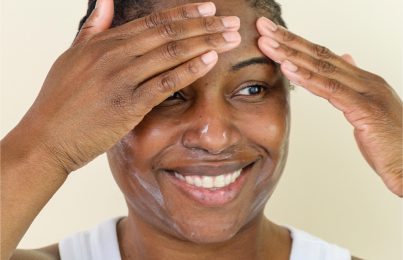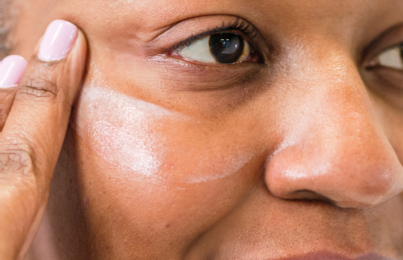Updated 12/1/17. I often hear people describing their skin as “dry on top but oily underneath.” Well, I’m here to set the record straight—you can’t have both dry and oily skin. If your skin is producing oil but still feels “dry,” what you’re actually experiencing is dehydration. Keep reading to learn how to fix this problem and how to differentiate between dry and dehydrated skin.
What is Dry Skin?
Dry skin is classified as skin that produces little to no oil and has small pores. This lack of oil causes dryness and flakiness, especially with age. Dry skin is a genetic condition. Some people are just born with fewer oil glands than others.
What is Oily Skin?
Oily skin is classified as skin that produces oil and has visibly larger pores. This causes the skin to get greasy and have a shine. Oily skin is a genetic condition characterized by active oil glands. Oily skin types are prone to clogged pores and breakouts.
What is Dehydrated Skin?
Dehydration is a temporary skin condition, not a genetic skin type. It is often found in oily, combination or normal skin that is lacking water (not oil), which causes the skin to feel tight. (Watch this quick video to see what dehydrated skin looks like.)
I often hear people with oily skin types saying their skin is feeling dry, but they’re still getting breakouts and aren’t sure how to treat this combo. This is a telltale sign that someone is dehydrated. If you’re getting breakouts or clogged pores, your skin is producing oil. If your skin is producing oil, you can’t be a true dry skin type. It’s that simple!
To remedy what feels like both dry and oily skin, these people might start using a heavy moisturizer formulated for dry skin, but this can cause more clogged pores, bumps, and breakouts. Sound familiar? Sometimes they think it’s because they don’t drink enough water, but hydration levels in the skin have very little to do with drinking water, despite what you’ve always been told.
The truth is that if your skin is naturally oily but acting “dry,” the underlying issue is probably something to do with your skincare routine. You may be using something too harsh.
Learn more about the differences between dry and dehydrated skin, as well as how to best care for it.
How to Treat “Dry and Oily” (A.k.a Dehydrated) Skin
In my thirty years as an esthetician, I’ve observed that the underlying cause of dehydration is usually harsh or drying skincare products. Here are some of my expert tips to get your skin healthy and balanced and alleviate the tight feeling caused by skin dehydration.
Choose Your Cleanser Carefully
Many foaming or gel cleansers are still formulated with ingredients called Sodium Lauryl Sulfate, Sodium Laureth Sulfate or Ammonium Laureth Sulfate. These are known as surfactants, which are cleansing agents that cut oil from the skin. While oily skin types do need the oil and shine to be broken down and removed by a cleanser, these ingredients are not in alignment with your skin’s natural pH and will strip too much water out of the skin after every washing. This is what leads to dehydration.
It’s important to know that what you cleanse with is the MOST important part of your skincare routine. Why? Because if you wash with a cleanser or soap that is too strong and drying, it pulls all the water out of the skin and creates a buildup of dead skin cells. The rest of your routine is then dedicated to trying to make up for this dehydration. When buying a cleanser, look for the words ‘sulfate-free’ on the bottle as this will imply that it’s a safe formula. You can get your skin properly cleaned while keeping the water in your skin where it belongs. Every good skincare routine should begin with a gentle cleanser.
Never Leave Your Skin Bare After Washing
After cleansing, you should quickly layer on an alcohol-free toner, serum (optional), and moisturizer. If you leave your skin bare for more than sixty seconds, it will start to dehydrate. After cleansing, it’s best to immediately apply an alcohol-free toner and then leave it damp on the skin when applying your next product. This way, your serum or moisturizer will lock in the hydrating benefits found in a toner.
Never Skip Moisturizer at Night so Your Skin Can “Breathe”
People with acne-prone skin are often worried about using moisturizer. They believe that it will clog their pores and not let the skin “breathe.” There are a few problems with this type of thinking. First, wearing moisturizer does not directly cause breakouts. Acne occurs when the cells that line the inner pores fail to fall off properly and the pore becomes clogged. This process happens whether you moisturize or not.
Second, respiration doesn’t happen in the skin. The concept of your skin breathing is false.
Those with oily, blemish-prone skin must use moisturizer no matter what. Your skin needs sufficient water to keep it healthy and balanced. The more balanced the hydration levels in your skin, the less likely it is to break out. Skipping moisturizer disrupts the skin’s water levels causing that “oily and dry” feeling we are talking about. This dehydration process actually stimulates more oil production, which potentially causes more breakouts.
The key here is to choose a moisturizer that is suitable for your skin type. Dry skin types need moisturizers that deliver oil into the skin while oily skin types require a moisturizer that gives water.
Use a Humidifier During the Winter Months.
If the air is moist, then the moisture in your skin will likely stay put rather than evaporating into the dry winter air. Learn more about how a humidifier can benefit your skin (and health!).
Use a Serum Underneath Your Moisturizer.
By applying a few drops of a lightweight, water-based skin serum underneath a moisturizer, you’ll get much-needed hydration to alleviate that tight feeling. I usually suggest that my clients with oily skin use Skin Drink Concentrate.
In summary, if you feel like you have dry, oily skin and your skin is feeling tight, you simply need to use a skincare routine that does a better job at balancing the water levels in your skin. It’s an easy fix!
Celebrity Esthetician & Skincare Expert
As an esthetician trained in cosmetic chemistry, Renée Rouleau has spent 35 years researching skin, educating her audience, and building an award-winning line of products. Her hands-on experience as an esthetician and trusted skin care expert has created a real-world solution — products that are formulated for nine different types of skin so your face will get exactly what it needs to look and feel its best. Trusted by celebrities, editors, bloggers, and skincare obsessives around the globe, her vast real-world knowledge and constant research are why Marie Claire calls her “the most passionate skin practitioner we know.”




Comments:
I read a lot of skincare blogs but something about the straightforward informativeness of this article is just perfect.
Thank you.
Posted By: Zee |
Thank you for enlightening us on the products we choose for our skin. This is a great guide!
Posted By: Four SeasonsLaser Center |
This post describes my dry oily skin perfectly. What skin type are you describing here? I know you referenced what to look for in products but which of your products meet the suggestions you listed?
Posted By: Katrina Rodis |
It sounds like you need lots of water-based hydration. Give our Bio Calm Repair Masque a try!
Posted By: Renée Rouleau |